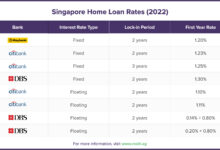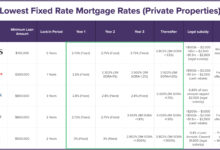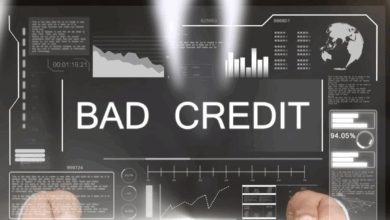Home Equity Loan Rates By Bank: Finding The Best Rates For You
Home equity loan rates by bank are a crucial aspect of financial planning, influencing your borrowing costs and overall financial health. Understanding how these rates work and comparing options can help you secure the best deal for your needs. Let’s dive into the world of home equity loan rates by bank and explore what you need to know to make informed decisions.
Analysis of the Impact of Climate Change on Arctic Wildlife
Climate change refers to the long-term alteration in Earth’s climate, primarily due to human activities such as burning fossil fuels, deforestation, and industrial processes. This phenomenon has led to a rise in global temperatures, resulting in various environmental changes worldwide.
Arctic wildlife populations are particularly vulnerable to the effects of climate change. The Arctic region is experiencing rapid ice melt, leading to a loss of habitat for species such as polar bears, seals, walruses, and Arctic foxes. These animals rely on sea ice for hunting, breeding, and resting, and the reduction in ice cover poses a significant threat to their survival.
Impact of Melting Sea Ice on Arctic Ecosystems
The melting of sea ice in the Arctic has a profound impact on the entire ecosystem. As the ice disappears, it disrupts the food chain, affecting species at all levels. For example, the loss of sea ice reduces the availability of prey for polar bears, making it harder for them to hunt and feed their young. This, in turn, can lead to a decline in polar bear populations.
- Melting sea ice also affects marine mammals such as seals and walruses, which rely on the ice as a platform for resting and giving birth. With less ice cover, these animals are forced to travel greater distances to find suitable habitats, increasing their energy expenditure and reducing their chances of survival.
- Furthermore, the decline in sea ice alters the distribution and abundance of plankton, a key food source for many Arctic species. This disruption in the food web can have cascading effects on the entire ecosystem, leading to population declines and changes in species composition.
Potential Solutions and Conservation Efforts
Conservation efforts are crucial in mitigating the impact of climate change on Arctic wildlife. These efforts include reducing greenhouse gas emissions, implementing sustainable practices, and establishing protected areas for vulnerable species.
- International agreements such as the Paris Agreement aim to limit global warming and reduce greenhouse gas emissions to prevent further climate change impacts. By working together on a global scale, countries can take collective action to protect the Arctic environment and its wildlife.
- Conservation organizations and researchers are also working on innovative solutions to address the challenges faced by Arctic species. These solutions may include habitat restoration, captive breeding programs, and community-based conservation initiatives.
Vulnerable Species in the Arctic Region
Several species in the Arctic region are particularly vulnerable to climate change, including:
- Polar Bears: Polar bears rely on sea ice for hunting seals, their primary prey. With the decline in sea ice, polar bears are facing food shortages and are at risk of starvation.
- Arctic Foxes: These small mammals are highly adapted to the Arctic environment and rely on sea ice for hunting seabirds and small mammals. The loss of ice cover threatens their food sources and breeding habitats.
- Walruses: Walruses use sea ice as a resting platform and for giving birth. The reduction in ice cover forces walruses to haul out on land, increasing the risk of stampedes and causing population declines.
Factors Affecting Home Equity Loan Rates
When it comes to home equity loan rates, several key factors play a crucial role in determining the interest rate you will be offered. Understanding these factors can help you make informed decisions when considering a home equity loan.
Loan Amount and Repayment Term
The loan amount and repayment term are significant factors that influence home equity loan rates. Generally, the larger the loan amount and the longer the repayment term, the higher the interest rate tends to be. Lenders often consider these factors when assessing the risk associated with the loan.
Credit Score Impact
Credit score plays a vital role in determining home equity loan rates. Borrowers with higher credit scores typically qualify for lower interest rates compared to those with lower credit scores. For example, a borrower with an excellent credit score of 800 may be offered a rate of 4%, while a borrower with a fair credit score of 650 might be offered a rate of 6%.
Loan-to-Value Ratio Influence
The loan-to-value (LTV) ratio, which is the ratio of the loan amount to the value of the property, also affects home equity loan rates. A lower LTV ratio signifies less risk for the lender, resulting in lower interest rates. For instance, a borrower with an LTV ratio of 80% may receive a rate of 5%, whereas a borrower with an LTV ratio of 90% could be offered a rate of 6.5%.
Market Conditions Role
Market conditions, such as interest rate trends and economic indicators, significantly impact home equity loan rates. During periods of low-interest rates, borrowers may secure more favorable rates, while economic downturns can lead to higher rates. It’s crucial to monitor market conditions to understand how they may affect your loan rate.
Fixed-Rate vs. Variable-Rate Loans
Fixed-rate and variable-rate home equity loans offer different benefits and risks that can impact the overall loan rate. Fixed-rate loans provide stability with a consistent interest rate throughout the loan term, whereas variable-rate loans may start lower but can fluctuate based on market conditions. Understanding the pros and cons of each type can help you decide which option aligns best with your financial goals.
Types of Home Equity Loan Products
When it comes to home equity loans, there are different types of products available to homeowners. These products can vary in terms of interest rates, repayment terms, and flexibility. It’s important to understand the options to make an informed decision based on your financial needs and goals.
Home Equity Loans vs. Home Equity Lines of Credit (HELOCs)
Home equity loans and HELOCs are both types of loans that allow homeowners to borrow against the equity in their homes. The main difference between the two is how the funds are disbursed. With a home equity loan, you receive a lump sum upfront and make fixed monthly payments over a set period. On the other hand, a HELOC acts more like a credit card where you have access to a line of credit and can borrow as needed, making minimum monthly payments based on the amount borrowed.
Fixed-rate Home Equity Loans vs. Variable-rate Loans
Fixed-rate home equity loans have a set interest rate that remains constant throughout the term of the loan, providing predictability in monthly payments. Variable-rate loans, on the other hand, have interest rates that can fluctuate based on market conditions, which can lead to changes in monthly payments. While fixed-rate loans offer stability, variable-rate loans may have lower initial rates but come with the risk of increasing payments over time.
Bank Structuring of Home Equity Loan Products
Banks structure their home equity loan products based on factors such as loan-to-value ratio, credit score, income, and debt-to-income ratio. These factors determine the loan amount, interest rate, and repayment terms offered to borrowers. Banks may also offer different promotional rates or incentives to attract customers, so it’s essential to compare offers from multiple lenders to find the best fit for your financial situation.
Understanding Interest Rates and APR
When it comes to home equity loans, understanding interest rates and APR is crucial in determining the overall cost of borrowing. Let’s delve into the details of how these factors can impact your finances.
Interest Rates in Home Equity Loans
Interest rates refer to the percentage of the loan principal that lenders charge borrowers for the privilege of borrowing money. In the context of home equity loans, the interest rate is the cost you pay to borrow against the equity in your home.
Fixed Interest Rate vs. Variable Interest Rate
A fixed interest rate remains constant throughout the life of the loan, providing predictability in monthly payments. On the other hand, a variable interest rate can fluctuate based on market conditions, potentially leading to changes in monthly payments.
Calculating Annual Percentage Rate (APR)
The Annual Percentage Rate (APR) includes not only the interest rate but also any additional fees or costs associated with the loan, giving you a more comprehensive view of the total borrowing cost. APR is calculated by considering the interest rate, points, and other charges over the loan term.
Impact of Interest Rates and APR on Total Cost
- Higher interest rates lead to increased monthly payments and higher overall costs over the life of the loan.
- A lower APR indicates a more cost-effective loan, considering all associated fees and charges.
- Understanding the relationship between interest rates and APR can help you choose the most affordable loan option for your financial situation.
Best Practices for Comparing Home Equity Loan Rates
When looking to secure a home equity loan, comparing rates from different banks is crucial to ensure you get the best deal possible. Here are some best practices to follow when comparing home equity loan rates:
Consider Additional Fees and Closing Costs
- It’s important to look beyond just the interest rate offered by banks and consider any additional fees or closing costs associated with the loan.
- Factors like origination fees, appraisal fees, and closing costs can significantly impact the overall cost of the loan, so be sure to factor these into your comparison.
Checklist for Evaluating Loan Offers
- Compare interest rates from multiple lenders to get an idea of the range of rates available.
- Review the terms and conditions of each loan offer, including the repayment period and any prepayment penalties.
- Consider the reputation and customer service of the lender, as this can impact your overall experience with the loan.
Negotiating for Better Rates
- Don’t be afraid to negotiate with banks to try and secure a better interest rate on your home equity loan.
- Use competing offers from other lenders as leverage to negotiate a lower rate with your preferred bank.
- Be prepared to walk away if you’re not satisfied with the rate offered and explore other options.
Trends in Home Equity Loan Rates
Home equity loan rates are influenced by various economic factors, including inflation, interest rates, and housing market conditions. To understand the trends in home equity loan rates, it is important to research and compare current rates from different financial institutions.
Impact of Economic Factors on Home Equity Loan Rates
- Inflation: High inflation rates can lead to higher home equity loan rates as lenders adjust their rates to account for the decrease in purchasing power of the currency.
- Interest Rates: Fluctuations in overall interest rates, particularly those set by the Federal Reserve, can directly impact home equity loan rates.
- Housing Market Conditions: The health of the housing market, including property values and demand for housing, can also influence home equity loan rates.
Data Visualization and Forecasting
Utilizing data visualization tools can help create graphs or charts illustrating historical trends in home equity loan rates over the past decade. Additionally, developing a regression model can forecast potential future changes in rates based on key economic indicators.
Implications for Homeowners
- Homeowners considering a home equity loan should closely monitor trends in rates to make informed decisions about when to secure a loan.
- Potential rate changes can impact the overall cost of borrowing and monthly payments, so understanding these implications is crucial.
Customer Experience with Different Banks’ Home Equity Loan Rates
When it comes to home equity loan rates, customer experiences with various banks can vary significantly. Here, we delve into the feedback and reviews from customers, highlighting their satisfaction levels and success stories with securing favorable rates.
Customer Satisfaction Levels
Customer satisfaction with home equity loan rates is often closely tied to how competitive the rates are compared to other banks. Those who secure lower rates tend to be more satisfied with their overall experience.
Impact of Customer Service
The perception of a bank’s home equity loan rates is heavily influenced by the quality of customer service. Banks that provide excellent customer service often receive higher ratings from customers, even if their rates are slightly higher.
Application Process Comparison
Each bank has its own unique application process for home equity loans. Some banks may have a more streamlined process, while others may require more documentation. Customers often value a smooth and efficient application process.
Interest Rate Fluctuations
Fluctuations in interest rates can impact customers’ decisions regarding home equity loans. Customers may rush to secure loans during periods of low rates or wait for rates to drop further before applying.
Top Banks Offering Competitive Rates
| Bank | Competitive Rate | Customer Rating |
|---|---|---|
| Bank A |
|
4.5/5 |
| Bank B |
|
4.2/5 |
| Bank C |
|
4.3/5 |
Tips for Negotiating Better Rates
- Do your research on current market rates before negotiating with the bank.
- Highlight your creditworthiness and financial stability to the bank.
- Consider bundling other financial products with the home equity loan for a better rate.
- Be prepared to walk away if the bank is unwilling to negotiate.
Regulatory Environment Impact on Home Equity Loan Rates
The regulatory environment plays a crucial role in shaping the home equity loan market. Changes in regulations can have a direct impact on the interest rates offered by banks to consumers. Government policies and consumer protection laws are key factors influencing the pricing of home equity loans.
Recent Regulatory Developments and Their Impact
Recent regulatory changes, such as updates to lending standards or interest rate regulations, can directly affect the rates at which banks offer home equity loans. For example, if there are stricter requirements for loan approval, banks may increase interest rates to offset the potential risks involved.
- Changes in lending standards can impact the availability of home equity loans and the rates offered to borrowers.
- Interest rate regulations imposed by regulatory bodies can influence the overall cost of borrowing for consumers.
- Government intervention in response to economic conditions can lead to fluctuations in home equity loan rates.
Consumer Protection Laws and Home Equity Loan Rates
Consumer protection laws are designed to safeguard borrowers from predatory lending practices and ensure fair treatment in the lending process. These laws can indirectly impact home equity loan rates by influencing how banks structure their loan products and pricing strategies.
- Disclosure requirements under consumer protection laws may impact the transparency of home equity loan rates offered by banks.
- Protections against unfair lending practices can contribute to a more competitive market, potentially leading to better rates for borrowers.
- Regulatory oversight of the lending industry can help maintain stability and prevent excessive risk-taking that could affect interest rates.
Geographic Disparities in Home Equity Loan Rates
Geographic location plays a significant role in determining home equity loan rates. Various factors such as urban versus rural areas, population density, local housing market trends, regulatory differences between states, and lender preferences can all impact the interest rates offered to borrowers.
Urban vs. Rural Home Equity Loan Rates
In urban areas, where housing demand is typically higher, home equity loan rates may be lower due to increased competition among lenders. On the other hand, in rural areas where housing demand is lower, rates may be slightly higher to offset the perceived risk of lending in less populous regions.
Population Density and Home Equity Loan Availability
Areas with higher population density tend to have more financial institutions and lenders, leading to increased availability of home equity loans. This competition can drive rates down as lenders vie for borrowers. In contrast, regions with lower population density may have fewer lending options, resulting in higher rates.
Local Housing Market Trends Impact
Fluctuations in local housing market trends can directly impact home equity loan rates. In areas experiencing a housing boom, lenders may offer lower rates to attract borrowers. Conversely, in areas where the housing market is stagnant or declining, rates may be higher to mitigate risk.
Regulatory Differences Between States
Each state has its own set of regulations governing home equity loans, which can influence interest rates. States with stricter lending laws may see higher rates as lenders adjust to comply with regulations. Conversely, states with more lenient regulations might have lower rates due to increased flexibility for lenders.
Role of Geographical Location in Interest Rates
Geographical location can directly impact the interest rates offered by lenders for home equity loans. Factors such as cost of living, regional economic conditions, and state-specific regulations all play a part in determining the rates borrowers receive. It is essential for borrowers to consider these geographical disparities when comparing loan options.
Technology and Innovation in Home Equity Loan Rate Offerings
In today’s digital age, technology plays a crucial role in transforming the way banks offer home equity loan rates. Online platforms and fintech companies have revolutionized the home equity loan market, providing customers with more options and convenience than ever before.
Role of Online Platforms and Fintech Companies
Online platforms and fintech companies have disrupted the traditional banking model by offering innovative solutions for home equity loan rates. These platforms allow customers to compare rates from multiple lenders, empowering them to make informed decisions based on their financial needs. Fintech companies also utilize data analytics and algorithms to provide personalized loan options tailored to individual borrowers.
Streamlining Application and Approval Process
Digital tools are being used by banks to streamline the application and approval process for home equity loans. Through online portals and mobile apps, customers can easily submit their documentation, track the status of their application, and receive instant approvals. This efficient process saves time for both the borrowers and the lenders, making the overall experience more seamless.
Innovative Approaches by Banks
Banks are adopting innovative approaches to attract customers with competitive home equity loan rates. Some institutions offer cashback incentives, discounted rates for existing customers, or flexible repayment options. By leveraging technology, banks can create unique value propositions that set them apart in a crowded market, ultimately benefiting the consumers.
Customer Education on Home Equity Loan Rates
Customer education on home equity loan rates is crucial in helping individuals make informed financial decisions. Understanding the intricacies of home equity loan rates can save consumers money and prevent them from falling into financial pitfalls.
Available Resources and Guides
- Banks’ websites: Many banks provide detailed information on their websites about home equity loan rates, terms, and conditions.
- Financial literacy websites: Online platforms like Investopedia or The Balance offer guides and articles on home equity loans and rates.
- Financial advisors: Seeking advice from a financial professional can provide personalized guidance on home equity loan rates.
Importance of Financial Literacy
Financial literacy plays a crucial role in understanding home equity loan rates. Consumers need to grasp concepts like interest rates, APR, and loan terms to make informed decisions.
Tips for Consumers
- Compare rates: Shop around and compare rates from different lenders to find the most competitive offer.
- Understand the terms: Pay attention to the fine print, including fees, penalties, and repayment terms.
- Ask questions: Don’t hesitate to ask your lender for clarification on any aspects of the loan agreement.
Effectiveness of Banks’ Education Efforts
Banks vary in their efforts to educate customers on home equity loan rates. Some institutions provide comprehensive resources, while others may offer limited information. It is essential for banks to prioritize customer education to build trust and transparency.
Case Studies: Comparing Home Equity Loan Rates from Different Banks
When considering a home equity loan, comparing rates from various banks is crucial to ensure you’re getting the best deal possible. Let’s delve into some case studies that highlight the differences in home equity loan rates offered by different banks and the factors influencing these rates.
Bank A: Fixed-Rate Home Equity Loan
- Interest Rate: 4.25%
- Loan Term: 15 years
- Additional Fees: Origination fee of 1% of the loan amount
Bank A offers a competitive fixed-rate home equity loan with a straightforward fee structure.
Bank B: Variable-Rate Home Equity Loan
- Initial Interest Rate: 3.75%
- Rate Cap: 6%
- Repayment Options: Interest-only payments for the first 5 years
Bank B provides a variable-rate option with a cap to protect borrowers from excessive rate increases.
Bank C: Hybrid Home Equity Loan
- Fixed-Rate Period: 5 years
- Variable-Rate Period: Remaining loan term
- Credit Score Requirement: Minimum FICO score of 680
Bank C offers a unique hybrid loan that combines the stability of a fixed rate with the flexibility of a variable rate.
Comparative Analysis
- Fixed-rate loans provide predictability and stability in monthly payments but may start with higher rates than variable-rate loans.
- Variable-rate loans offer lower initial rates but come with the risk of rate fluctuations over time.
- Hybrid loans combine the benefits of fixed and variable rates, appealing to borrowers seeking a middle ground.
Future Outlook for Home Equity Loan Rates
The future outlook for home equity loan rates is influenced by various factors such as economic conditions, regulatory changes, technological advancements, and market trends. Let’s delve into how these elements may shape the landscape of home equity loan rates in the coming years.
Predicted Evolution of Home Equity Loan Rates
Home equity loan rates are expected to experience gradual increases over the next five years, in line with the projected rise in overall interest rates. As the economy continues to recover and grow, lending institutions may adjust their rates to reflect market conditions and manage risk effectively.
Impact of Regulatory Changes
Potential regulatory changes, such as adjustments to lending standards or government interventions in response to economic fluctuations, could significantly impact home equity loan rates. Increased compliance requirements or changes in tax policies may lead to shifts in interest rates to align with new regulations.
Role of Technology in Setting Rates
Technology, particularly AI algorithms, plays a crucial role in predicting and setting home equity loan rates. By analyzing vast amounts of data and market trends, financial institutions can leverage technology to optimize their rate offerings and provide competitive options to borrowers.
Relationship between Mortgage Rates and Home Equity Loan Rates
Fluctuations in mortgage interest rates can directly influence home equity loan rates, as both are interconnected within the broader housing finance landscape. Changes in one type of rate may lead to adjustments in the other, impacting borrower decisions and loan affordability.
Comparative Analysis of Loan Types
When considering fixed-rate versus variable-rate home equity loans, different economic scenarios must be taken into account. Fixed-rate loans offer stability and predictability, while variable-rate loans may provide flexibility but carry the risk of rate adjustments based on market conditions.
Scenario Analysis Table
In a scenario analysis table, various economic indicators such as inflation rate and unemployment rate can be mapped to illustrate how they influence home equity loan rates. This visual representation can help borrowers anticipate potential rate changes and make informed decisions.
A consumer exploring home equity loan options should carefully assess their financial goals, research different loan products, compare rates from multiple lenders, and seek professional guidance to secure the most favorable terms.
Final Conclusion
In conclusion, navigating the landscape of home equity loan rates by bank requires careful consideration and research. By staying informed and comparing offers, you can find the most competitive rates that align with your financial goals. Make sure to explore different banks and their offerings to secure a home equity loan rate that works best for you.







